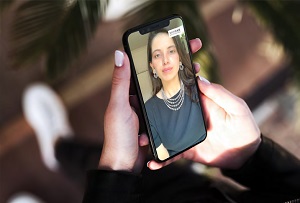Every crisis gives birth to many opportunities and this pandemic has turned agnostics into believers of technology, thanks to enablers like mirrAR. Meghna Saraogi, Founder & CEO talks about why retailers should adopt AR and throws light on some of mirrAR’s latest solutions

An industry which has been traditionally laid back when it comes to technology has embraced the same in full swing post Covid 19. Every crisis gives birth to many opportunities and this pandemic has turned agnostics into believers of technology. mirrAR, Indian fashion tech startup StyleDotMe’s Augmented Reality technology, has revolutionised the jewellery industry by enabling virtual try ons in real time. With a strong client portfolio consisting of 200+ jewellers like Tanishq, Kalyan Jewellers, Senco, HazooriLal Legacy, etc. across 45+ cities, mirrAR is now even ready to enter the global market.
Recently, understanding the industry’s need for a more specific solution, mirrAR launched WebAR. The website solution solves the age old problem of not knowing what the actual product will look like or how the customer will feel after an online purchase. In case, jewellers do not have a website, this feature can still set up a digital store showcasing all their inventory with a try on button & the link will be accessible on all browsers. No additional app downloaded is needed. The biggest brands in the country including players such as HazooriLal Legacy, Tanishq & Sawansukha trust the brand for their business needs.
What is WebAR?
With WebAR, jewellers can enable virtual try ons for their jewellery, which makes the customer sure of what he’s investing in, which further leads to increased conversions, fulfilled expectations & lower return rates. Instead of showing customers a simple product catalogue, jewellers can now make their shopping experience more engaging by adding that ‘try-on’ feature! Especially right now, in this contactless world, jewellers are using WebAR to connect with customers outside the physical boundaries of their stores & to increase conversions by making their business strategy an omnichannel one. Some of the features & benefits include:
Virtual Try-Ons: It’s not just about the scroll on the website anymore. Virtual tryon enables customers to try-on jewellery pieces on the website in real time. Reduced Return Rates: Customers can now experience what it feels like to own a product even before they pay for it. This surety builds trust & reduces return rates. Data Analytics: Jewellers get access to details about maximum selected product items, highest wish-listed product item, preferred product category and more! Full Control: Get access to a dashboard which allows you to add & manage your digitised Inventory, pricing, security features. CAD Try-On: Our tech supports CAD and hand-sketches. Add designs to the website, let people try-on virtually & then take orders to manufacture. Safety & Security: Data integrity is of utmost importance! Each step from signing up to the credentials to adding and managing inventory is 100% secure.
Youngsters want customized jewellery – how can WebAR help with that?
If a customer sees a product in ruby and wants the entire piece in emerald, it is impossible for a retailer to get the entire set manufactured in emerald. At present, through AR you can change the colours and gold can changed from yellow gold, to rose gold or white gold. Jewellers may not necessarily have all these types in their store in physical inventory – but AR gives them time to procure it and send it to the client. AR can bridge this gap.
Does AR lead to actual sales and how can it be made cost effective for jewellers?
There is some occasion for which one wants to buy jewellery – even if it is not an urgent need. It could be one of those social media popups and you get intrigued by AR and want to see how it looks on you. There are two parts to buying – it allows the customer to experience trying on jewellery virtually, that eventually lead to sales. A customer wants to buy when there is a real occasion – jewellery shopping is usually not impulsive. In case of fashion jewellery however, AR boosts sales greatly – because it is affordable and can be done. Not many jewellers have their own website. We have a simple way wherein jewellers can put all their inventory onto our software and we can upload their banner and they are good to go. It is like their own virtual store. They need not have their own website. The costs are quite nominal from Rs 2000 to up to Rs 5 lakh a month. So he range of AR products we offer are many, from small time jewellers to big ones all can avail whatever they want.

A lot of the buying decision also depends on the weight, touch and feel factor. How can your solutions bridge this gap?
At present, the only hurdle is that we are not able to give the weight experience in AR – but later on in newer versions that we working on we can add in the weight of each piece and how much weight a woman’s ears will actually have to bear. At present we can show how big or small the earrings look – that gives customers a fairly good idea about the weight as well. There will always be a thin line between real and virtual. At present we are trying to bridge the gap as much as possible
What does a retailer need to have to in order to use AR effectively and stay ahead of the curve?
Online presence is a must for every jewellery retailer—especially in the post Covid 19 world. A retailer can survive only if he has an online presence Geography should not be constraint for a retailer – the world should be his client – he can achieve this only if his website offers ecommerce options. In fact, today even if he can reach out to customer located just two lanes away it is good for any jeweller. Brands across the world are working on various technologies to bring jewellery buying onto smartphones or laptops. The younger generation who will now start shopping for jewellery has a short attention span. It is therefore extremely important to allow the customer a near real experience. Customers should be able to view your store online – checkout all the inventory and only then will they even consider walking in to the store.
There’s an assumption that very expensive jewellery cannot be sold over AR – could you please bust a few myths surrounding AR?
I agree, if someone wants to buy bridal jewellery she may not buy it with the click of a button without actually seeing or touching the jewellery in real time – because of the high cost involved. All the same, a bride can wear her bridal lehenga at home and she can virtually try on as many bridal jewellery sets as she desires. So she knows exactly which set looks best with her bridal outfit. If a customer can browse inventory from 5-6 different stores in the area --- try on the different jewellery pieces and then compare prices etc and make the right buying decision, it is going to bring in more satisfaction for a customer. A customer can shortlist the jewellery she likes by adding it to her wishlist– and when she goes to the store – she can see only those many pieces and buy jewellery in lesser time.
For everyone who thinks that AR can make immediate sales – it doesn’t work that way – AR helps generate many strong leads. AR is a strong tool to increase sales which helps create a world-class experience for your customers. It can make customers decide what they really want to buy. You are able to create a strong lead in lesser time. AR is not a toy or technological gimmick; it is a very strong tool that helps build sales with regular use. It is beneficial to store owners who need not have physical inventory in their store – they just need to upload all the designs onto the AR software and allow customers to browse through a wide range of products and when they actually place the orders – they can procure those pieces and despatch them. It saves a lot of capital investment. AR enhances your brand image, gives your customers a wide range of inventory to choose from and helps you save up on capital investment as well. AR, therefore is a strong tool and a must in this day and age for every jewellery retailer.
Be the first to comment